Most downloaded
- Page Path
-
- HOME
- BROWSE ARTICLES
- Most downloaded
"Most downloaded" Articles are from the articles published in 2023 during the last six months.
- Review Article
- Endocrinology
- Impact of hematopoietic stem cell transplantation on growth outcomes in mucopolysaccharidosis: a systematic review (52 times)
- Farzaneh Abbasi, Asal Khalili Dehkordi, Reihaneh Mohsenipour
- Clin Exp Pediatr. 2025;68(6):417-427. Published online March 11, 2025
-
Hematopoietic stem cell transplantation (HSCT) enhances the growth outcomes of pediatric patients with mucopolysaccharidosis, with early intervention leading to improved height, weight, and body mass index. However, achieving a standard adult height remains uncommon among these patients, even in cases of early HSCT. Growth hormone therapy provides short-term benefits but does not address long-term height deficits. Pubertal development is generally normal; however, precocious puberty and pubertal arrest may occur.
- Original Article
- Infection
- Carbapenem resistance in gram-negative pathogens in an Iranian hospital: high prevalence of OXA-type carbapenemase genes (52 times)
- Setareh Mamishi, Reihaneh Hosseinpour Sadeghi, Sadaf Sajedi Moghaddam, Babak Pourakbari, Shiva Poormohammadi, Maryam Sotoudeh Anvari, Shima Mahmoudi
- Clin Exp Pediatr. 2025;68(1):65-72. Published online October 31, 2024
-

Question: What is the prevalence of carbapenem resistance in gram-negative bacteria and associated carbapenemase genes?
Findings: This study identified a notable prevalence of carbapenem-resistant gram-negative isolates, with Escherichia coli being the predominant contributor, follow ed by Klebsiella pneumoniae, Acinetobacter baumannii, while bla OXA48 was the most prevalent carbapenemase gene.
Meaning: These findings highlight the urgent need for proactive measures including the rapid detection of carbapenemase- producing isolates and effective infection control.
- Other
- Role of neutrophil elastase in predicting infection among children with chemotherapy-induced febrile neutropenia (52 times)
- Mahmoud A. El-Hawy, Doaa M. Elian, Mai El-Sayad Abd El-Hamid, Esraa T. Allam, Mariam S. Kandeel, Asmaa A. Mahmoud
- Clin Exp Pediatr. 2025;68(10):801-807. Published online June 10, 2025
-
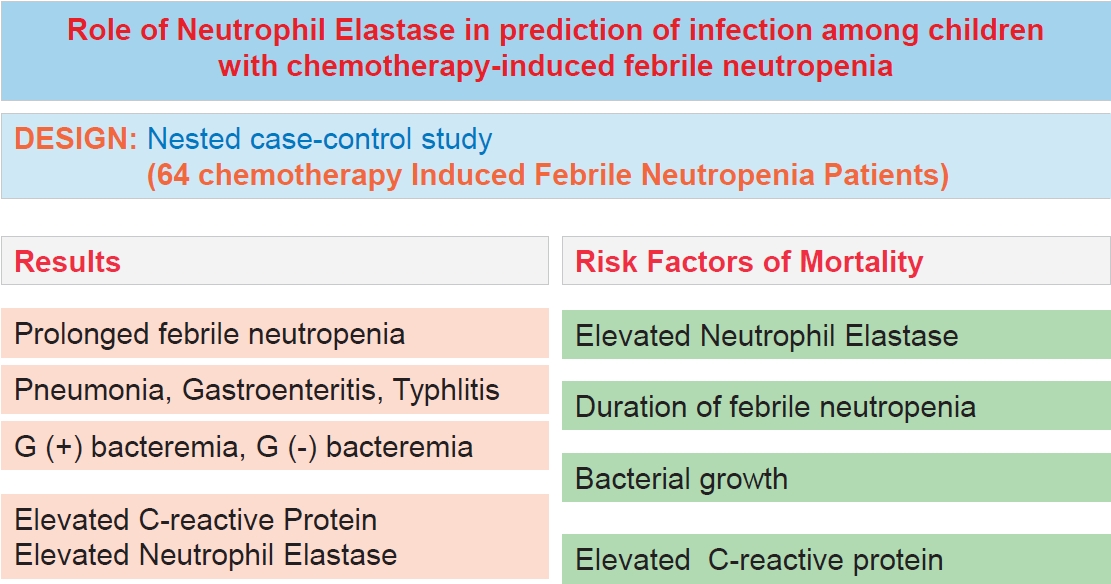
Question: Can neutrophil elastase (NE) levels predict infection— the primary cause of mortality—among children with hematological malignancies and febrile neutropenia (FN)?
Finding: Elevated levels of NE were found in children with chemotherapy-induced FN and a bacterial infection.
Meaning: Increased NE levels and prolonged FN are important factors associated with mortality risk.
- Review Article
- Endocrinology
- Continuous glucose monitoring in Korean pediatric patients with type 1 diabetes: current landscape and clinical implications (52 times)
- Hwa Young Kim, Jaehyun Kim
- Clin Exp Pediatr. 2025;68(11):842-851. Published online October 2, 2025
-

Continuous glucose monitoring (CGM) has transformed pediatric type 1 diabetes care by facilitating tighter glycemic control, reducing hypoglycemia, and improving quality of life.
Recent advances in CGM technology and the expansion of insurance coverage in Korea have led to its broader adoption.
Emerging metrics such as time in tight range offer refined tools for individualized glycemic assessment, highlighting CGM’s evolving role in personalized pediatric diabetes management.
- Gastroenterology
- Neonatal ichthyosis-sclerosing cholangitis syndrome caused by a novel CLDN1 mutation: a case report and literature review (52 times)
- Upasana Ghosh, Ankit Agrawal, Varunvenkat M. Srinivasan, Rani Manisha, Umesh Shukla, Vikas Jain, Mayank Nilay, Harish Kumar
- Clin Exp Pediatr. 2025;68(11):858-867. Published online October 2, 2025
-

· Neonatal ichthyosis-sclerosing cholangitis (NISCH) syndrome is a rare autosomal recessive disorder characterized by cholestasis and manifestations such as generalized ichthyosis, alopecia, and dental anomalies.
· The clinical features of NISCH syndrome are distinct and necessitate an early genetic diagnosis.
· The disease phenotype can vary significantly, ranging from no liver involvement and transient neonatal cholestasis to end-stage liver disease.
· Management requires a multidisciplinary approach with long-term follow-up.
- Update on eosinophilic gastrointestinal disease beyond eosinophilic esophagitis in children (51 times)
- Hye Ran Yang
- Clin Exp Pediatr. 2023;66(6):233-239. Published online January 3, 2023
-

· Eosinophilic gastrointestinal disease (EGID) is uncommon, with a prevalence of 1–30/100,000 in the general population; however, it is increasing worldwide.
· The diagnosis of EGID is based on histopathological findings of endoscopic mucosal biopsy in which tissue eosinophils are counted in each gastrointestinal tract segment of patients with chronic or recurrent gastrointestinal symptoms.
· Individualized treatment strategies, including adequate dietary and pharmacological therapy, may help improve outcomes of children with EGID.
- Nutrition
- Total energy expenditure measured by doubly labeled water method in children and adolescents: a systematic review (51 times)
- Nahyun Kim, Jonghoon Park
- Clin Exp Pediatr. 2023;66(2):54-65. Published online October 17, 2022
-
This systematic review summarizes convincing evidence that total energy expenditure (TEE) measured using the doubly labeled water technique increased with age from 1 to 18 years, while fat-free mass (FFM) increased with growth. TEE and in normal-weight participants, while physical activity level did not differ from that of normal-weight participants.
- Gastroenterology
- Practical concepts and strategies for early diagnosis and management of eosinophilic gastrointestinal disorders in East-Asian children (51 times)
- Byung-Ho Choe
- Clin Exp Pediatr. 2025;68(3):185-198. Published online November 13, 2024
-
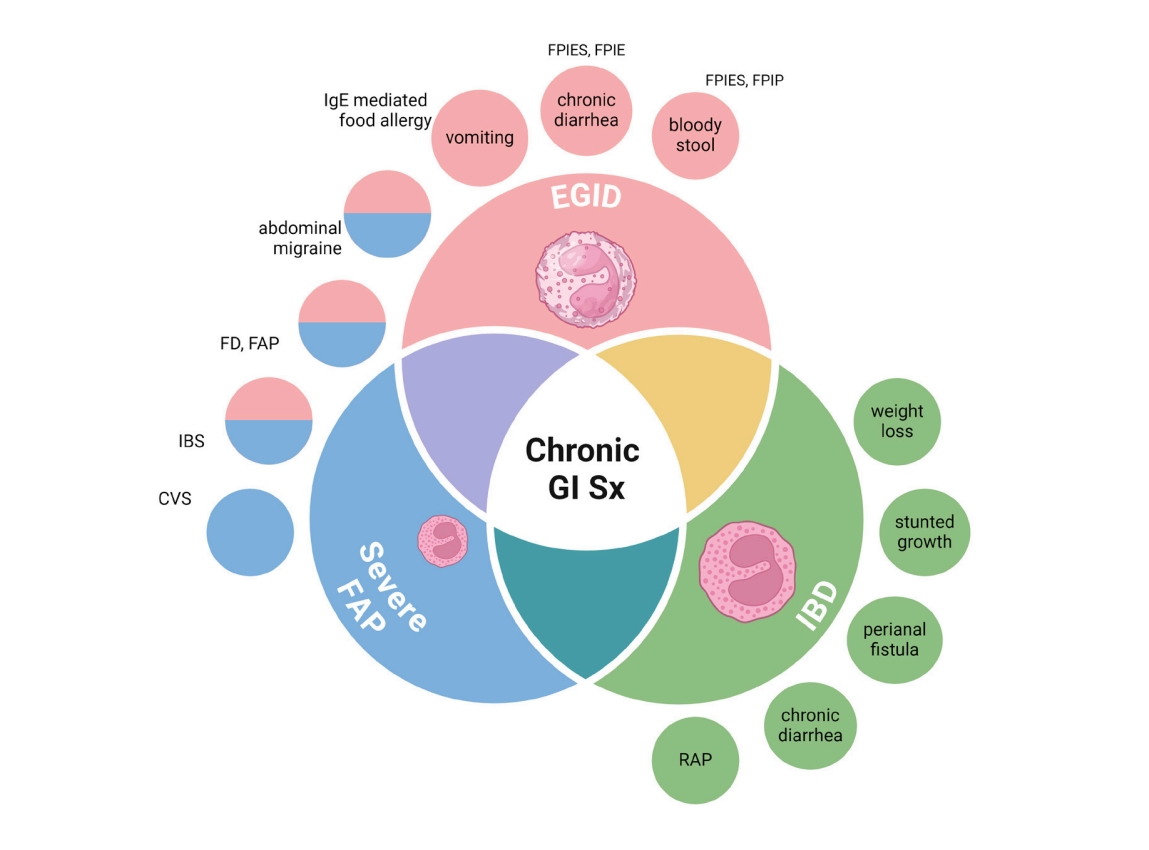
Eosinophilic gastrointestinal disorders (EGIDs) often coexist with functional gastrointestinal disorders (FGIDs) and other IgE or non-IgE mediated GI diseases. Diagnosing EGIDs requires a high index of suspicion and a comprehensive approach to differentiate them from conditions like inflammatory bowel disease. Tests such as fecal calprotectin and biopsies aid in severe cases. Maintaining a food diary helps identify triggers for long-term elimination. Awareness and education are key to effective management.
- Original Article
- Pulmonology
- Nonlinear association between neutrophil-to-lymphocyte ratio and asthma in children and adolescents in the United States: a cross-sectional study (51 times)
- Chuhan Cheng, Liyan Zhang
- Clin Exp Pediatr. 2025;68(7):489-496. Published online March 11, 2025
-

Question: Is there a nonlinear relationship between neutrophil-to-lymphocyte ratio (NLR) and asthma in children and adolescents?
Finding: NLR showed a nonlinear association with asthma, with an NLR threshold of 2.23 identifying individuals at higher risk.
Meaning: An NLR<2.23 may serve as a potential biomarker for asthma risk assessment and management in pediatric populations, thereby offering a simple tool for the early identification of at-risk individuals.
- Hematology
- Hyperhomocysteinemia in pediatric β-thalassemia: links to vitamin cofactor deficiencies and oxidative stress (51 times)
- Arzu Dadashova, Gunay Aliyeva, Rana Rahimova, Gulnara Azizova, Khayala Mammadova
- Clin Exp Pediatr. 2025;68(10):819-830. Published online July 8, 2025
-
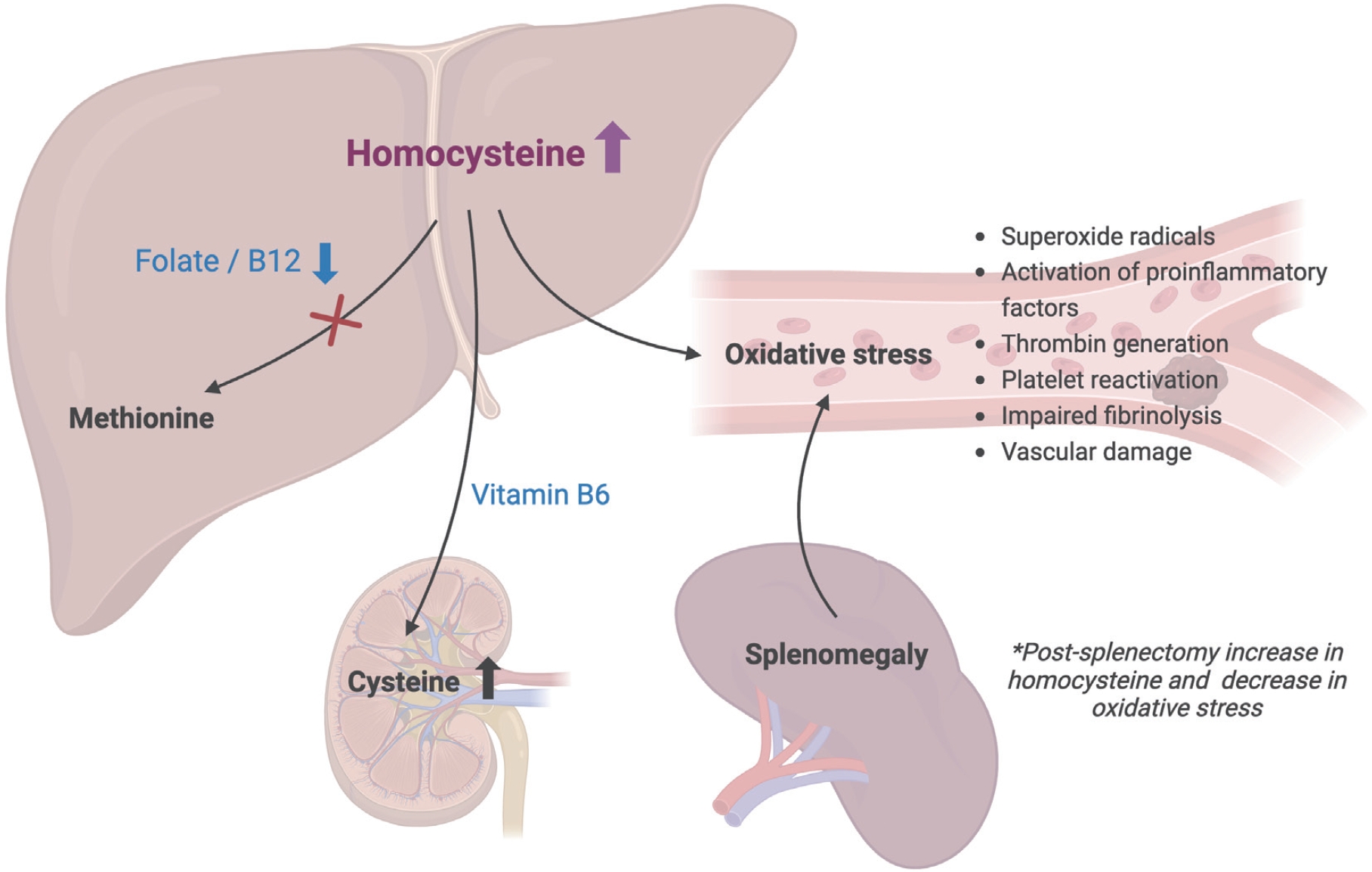
Question: What are the biochemical and clinical correlates of hyperhomocysteinemia in pediatric β-thalassemia, and how does it relate to vitamin status, oxidative stress, and splenectomy?
Finding: Most pediatric β-thalassemia patients exhibited severe hyperhomocysteinemia, which was strongly associated with folate and B12 deficiencies and influenced oxidative stress patterns, particularly in splenectomized individuals.
Meaning: These findings suggest that routine monitoring and correction of B-vitamin deficiencies may mitigate hyperhomocysteinemia-related risks in pediatric thalassemia.
- Review Article
- Pulmonology
- Long COVID in children and adolescents: prevalence, clinical manifestations, and management strategies (50 times)
- Eun Kyo Ha, Ju Hee Kim, Man Yong Han
- Clin Exp Pediatr. 2023;66(11):465-474. Published online June 19, 2023
-
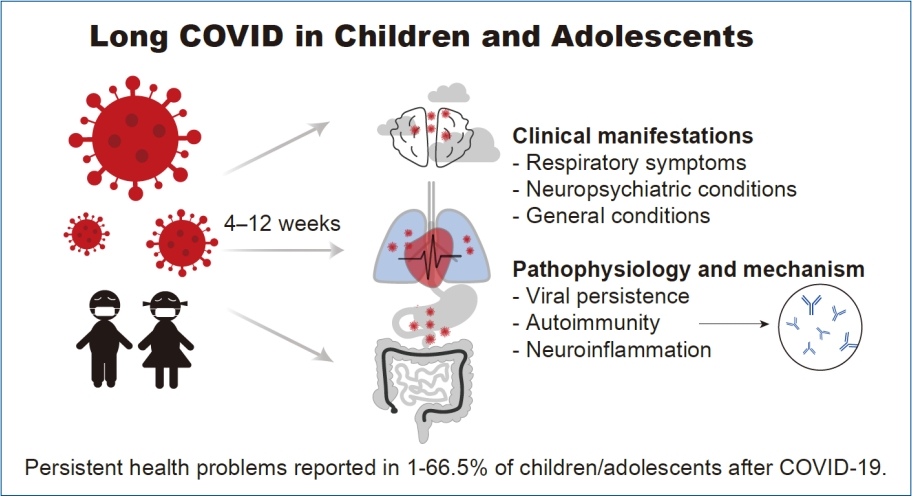
· Current definitions of long coronavirus disease (COVID) in children and adolescents vary in duration, ranging from 4 to 12 weeks or more.
· The clinical spectrum of long COVID in children and adolescents comprises a wide range of symptoms and might be a multisystem disorder.
· Persistent health problems with a prevalence of 1%–66.5% were reported in children and adolescents after COVID-19, with a higher incidence of persistent single or multiple symptoms.
- Original Article
- Oncology
- Prognostic role of mid-regional pro-adrenomedullin in predicting infection in pediatric cancer with febrile neutropenia (50 times)
- Seham M. Ragab, Sara Mahmoud El-Deeb, Ahmed Saeed, Asmaa A. Mahmoud
- Clin Exp Pediatr. 2025;68(6):445-453. Published online January 13, 2025
-

· Infection remains a leading cause of death in febrile neutropenia (FN).
· Mid-regional pro-adrenomedullin (MR-ProADM) levels are higher among patients with FN and a bacterial infection.
· A longer FN duration and hospital stay length as well as elevated C-reactive protein, procalcitonin, and MR-ProADM levels are significant risk factors for mortality.
- Allogeneic stem-cell transplantation following chimeric antigen receptor T-cell therapy for treatment of relapsed/refractory hematologic malignancy in children and young adults: a systematic review and meta-analysis (50 times)
- Ghea Mangkuliguna, Edi Setiawan Tehuteru, Reganedgary Jonlean, Nicholas Adrianto, Stella Kallista
- Clin Exp Pediatr. 2025;68(9):712-721. Published online July 4, 2025
-

Question: Does consolidative allogeneic stem cell transplantation (allo-SCT) after chimeric antigen receptor (CAR) T-cell therapy improve outcomes of children and young adult patients with relapsed/refractory hematologic malignancies?
Finding: The meta-analysis showed reduced relapse rates and favorable survival trends with allo-SCT despite low evidence quality.
Meaning: Consolidative allo-SCT after CAR T-cell therapy may enhance survival; however, further clinical studies are needed.
- Review Article
- Endocrinology
- Nonalcoholic fatty liver disease and insulin resistance in children (49 times)
- Kyungchul Song, Ho-Seong Kim, Hyun Wook Chae
- Clin Exp Pediatr. 2023;66(12):512-519. Published online January 9, 2023
-

· The prevalence of pediatric nonalcoholic fatty liver disease (NAFLD) increased from 8.2% in 2009 to 12.1% in 2018 in Korea.
· Laboratory tests, biomarkers, and imaging studies are used for the early detection of NAFLD.
· Insulin resistance is closely related to NAFLD.
- Cardiology
- Lifelong impact of elevated blood pressure from childhood to adulthood (49 times)
- Junhyun Kwon, Eunji Kim
- Clin Exp Pediatr. 2025;68(4):278-286. Published online November 28, 2024
-

· Childhood blood pressure (BP) is significantly associated with adult hypertension and cardiovascular disease.
· Despite ongoing debate regarding the need for regular BP screening and early pharmacotherapy in children, the benefits of optimizing BP throughout childhood are clear.
· Childhood presents a critical window for normalizing BP through lifestyle modifications such as reducing sodium intake and increasing physical activity to promote lifelong cardiovascular health and prevent longterm complications.
- Original Article
- Neonatology (Perinatology)
- Short-term outcomes of oropharyngeal administration of colostrum in preterm neonates: a double-blind placebocontrolled randomized trial (49 times)
- Ameneh Lamsehchi, Maryam Shokouhi Solgi, Mohammad Kazem Sabzehei, Behnaz Basiri, Elahe Talebi Ghane, Kiana Kimiaei Asadi, Sina Azadnajafabad
- Clin Exp Pediatr. 2025;68(1):73-79. Published online October 31, 2024
-

Question: What are the short-term outcomes of oropharyngeal administration of colostrum (OAC) in preterm neonates?
Finding: This study demonstrated the significantly lower rates of necrotizing enterocolitis, clinically suspected sepsis, shorter hospital stay, period to full enteral feeding, and antibiotic therapy period in the OAC group.
Meaning: This trial may further expand the clinical application of OAC in premature infants to reduce their length of hospital stay and complications.
- Review Article
- Neurology
- Electroencephalography source localization (48 times)
- Tae-Hoon Eom
- Clin Exp Pediatr. 2023;66(5):201-209. Published online December 29, 2022
-
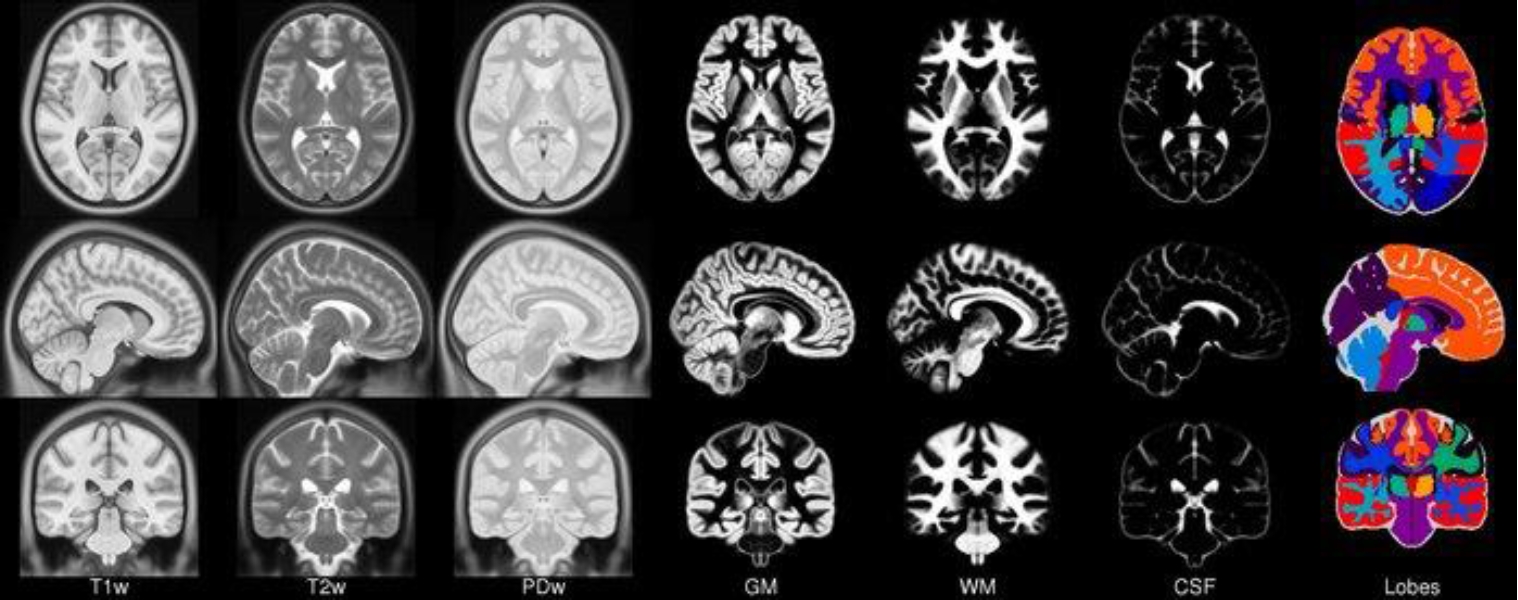
· Electroencephalography (EEG) directly images the electrical activity of neurons at a higher temporal resolution than other neuroimaging techniques.
· EEG is still widely used in brain function research due to its advantages.
· Forward and inverse problems of EEG analyses require solutions.
· Methods such as the dipole and distributed source models have been introduced.
· Applications of EEG are expanding with the integration of other technologies and large-scale data.
- Allergy
- Skin and oral intervention for food allergy prevention based on dual allergen exposure hypothesis (48 times)
- Kiwako Yamamoto-Hanada, Yukihiro Ohya
- Clin Exp Pediatr. 2024;67(10):477-485. Published online June 14, 2023
-

To prevent food allergy in infants, based on the dual allergen exposure hypothesis, we recommend a personalized approach consisting of both skin intervention (eczema treatment to achieve early remission and well-controlled skin without eczema to prevent percutaneous immunoglobulin E sensitization) and oral intervention (early allergenic food introduction).
- Editorial
- Allergy
- Comorbidities of allergic rhinitis in children (48 times)
- Yong Ju Lee
- Clin Exp Pediatr. 2024;67(12):675-676. Published online July 31, 2024
-
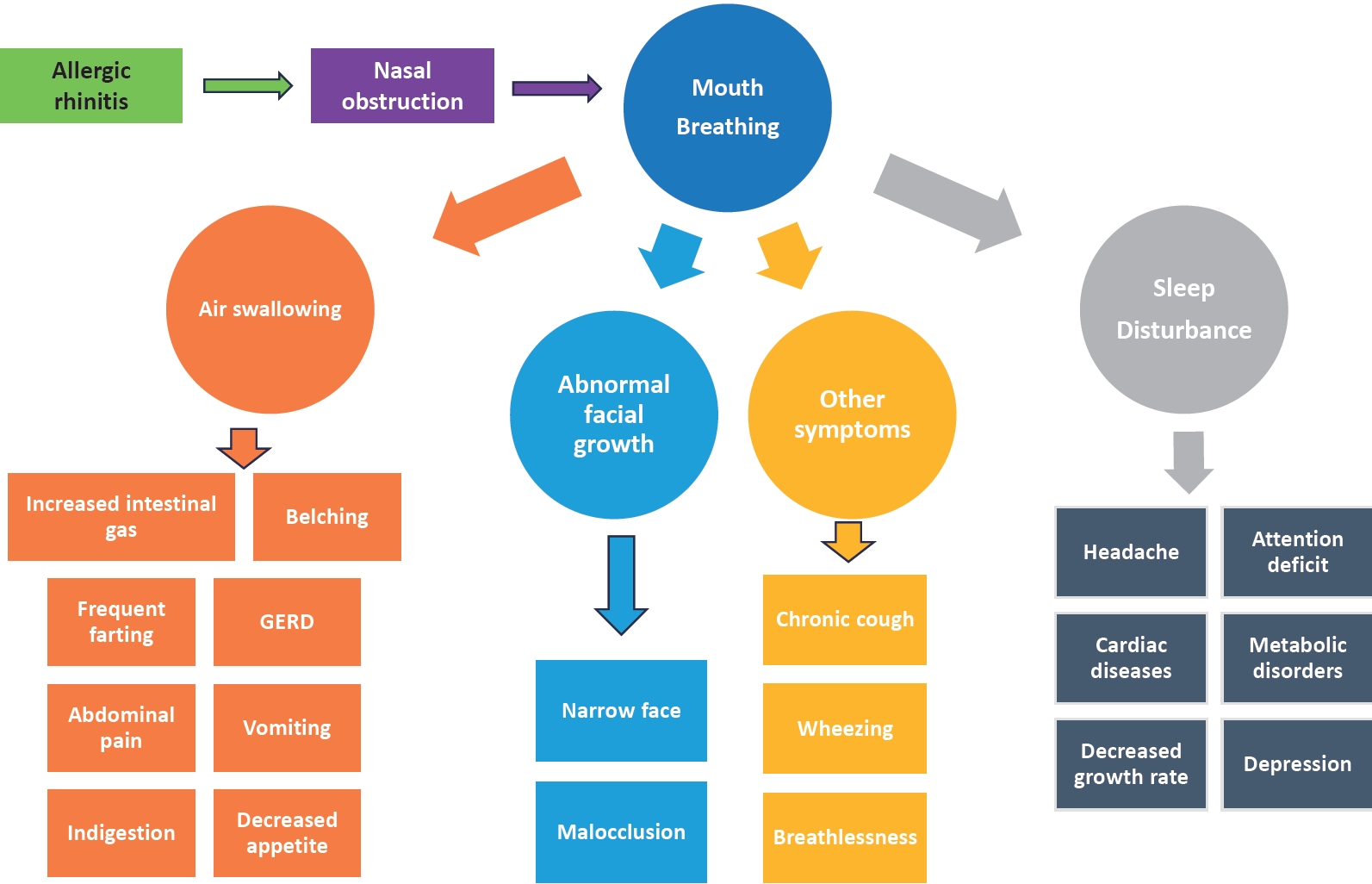
· Allergic rhinitis in children often goes undiagnosed or untreated, with significant systemic complications like sleep disorders, growth issues, and gastrointestinal symptoms linked to nasal obstruction.
· A patient-centered action plan that considers symptom severity, preferences, and comprehensive management of associated complications is essential for effective treatment.
- Original Article
- Nutrition
- Success rates of conservative treatment and optimal surgical timing for pediatric chylothorax (48 times)
- Pakwan Kaewchusen, Narumon Densupsoontorn, Supaluck Kanjanauthai, Puthita Saengpanit
- Clin Exp Pediatr. 2025;68(11):871-878. Published online August 6, 2025
-

Question: What is the success rate of conservative treatment for pediatric chylothorax, and when should surgical intervention be employed?
Finding: Overall success rate of conservative treatment was 83.3%. Surgically related etiologies and lower peak pleural fluid drainage rates were significantly associated with successful conservative management of pediatric chylothorax.
Meaning: If chylous drainage persists at ≥10 mL/kg/day beyond 2 weeks of optimal conservative treatment, surgical intervention should be considered.
- Gastroenterology
- Fecal microbiome profiles in infants with biliary atresia versus nonbiliary atresia cholestasis: a pilot study (48 times)
- Nur Azizah, Fadilah Fadilah, Silvia Werdhy Lestari, Muzal Kadim, Fithriyah Sjatha, Hanifah Oswari
- Clin Exp Pediatr. 2025;68(11):932-943. Published online August 20, 2025
-

Question: How does the gut microbiota profile of infants with biliary atresia (BA) differ from that of infants with non-BA cholestasis and healthy infants in the Indonesian population?
Finding: The unique fecal microbiome composition of the BA group differed significantly from that of the other 2 groups.
Meaning: There is an urgent need to improve dysbiosis in BA and non-BA cholestasis to prevent worsening liver injury in cholestasis.
- Review Article
- Allergy
- Action-plan and as-needed therapy in allergic rhinitis (47 times)
- Hyeon-Jong Yang
- Clin Exp Pediatr. 2024;67(6):267-273. Published online May 21, 2024
-

· The guidelines may not work in the real world.
· An action-plan reflecting patient’s severity and variable of symptoms, values and preferences as well as the benefits and harms of treatment, may be a useful alternative.
· The action plan and as-needed therapy must include the following elements: when, what, how, and why.
· Action plan and as-needed therapy can help patients manage their symptoms more effectively.
- Original Article
- Pulmonology
- Association of macrophage migration-inhibitory factor gene and growth differentiation factor 15 gene polymorphisms and their circulating levels with respiratory distress syndrome among preterm neonates (47 times)
- Ali Helmi Bakri, Mohammed H. Hassan, Khaled Abdalla Abd-Elbaseer, Mahmoud Abo-Alhassan Sayed, Ahmed Alamir Mahmoud Abdallah, Eman Ahmed Abd-Elmawgood
- Clin Exp Pediatr. 2025;68(9):680-689. Published online April 1, 2025
-

Question: Do macrophage migration-inhibitory factor (MIF) and growth differentiation factor-15 (GDF-15) levels and their gene polymorphisms affect RDS among preterm babies?
Finding: Significantly higher serum MIF and GDF-15 levels were observed in patients with severe respiratory distress syndrome (RDS). The mutant G- and C-alleles of GDF-15 rs4808793 C>G single nucleotide polymorphism (SNP) and MIF rs755622 G>C SNP were present at significantly higher frequencies in preterm neonates with RDS.
Meaning: MIF and GDF-15 play a significant role in neonatal RDS and its severity.
- Review Article
- Allergy
- Practical issues of oral immunotherapy for egg or milk allergy (46 times)
- Sukyung Kim, Kangmo Ahn, Jihyun Kim
- Clin Exp Pediatr. 2024;67(3):140-148. Published online June 19, 2023
-
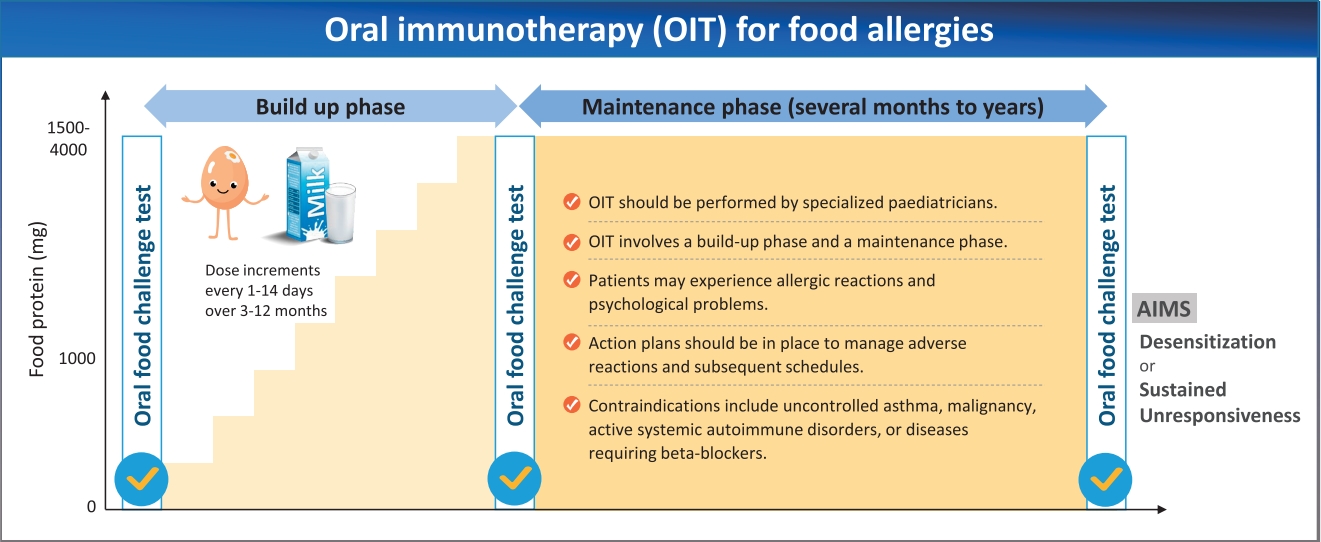
· Oral immunotherapy should be supervised by pediatricians with experience administering oral food challenge tests and managing allergic reactions.
· Food allergen intake is gradually increased and maintained for years.
· Patients may experience allergic reactions and psychological problems.
· Adjunctive therapies (biologics, antihistamines, and leukotriene receptor antagonists) may improve efficacy and safety.
· Contraindications include uncontrolled asthma, malignancy, active autoimmune disorders, and beta-blocker usage.
- Neurology
- Gut microbiota affects brain development and behavior (45 times)
- Gun-Ha Kim, Jung-Ok Shim
- Clin Exp Pediatr. 2023;66(7):274-280. Published online November 8, 2022
-

· The gut microbiota can alter a host’s brain development and behavior.
· Gut bacteria communicate with the brain via the microbiota-gut-brain axis.
· Fecal microbial transplantation is a promising treatment strategy for autism spectrum disorder.
- Endocrinology
- A review of vitamin D deficiency and vitamin D receptor polymorphisms in endocrine-related disorders (45 times)
- Nur Faten Hafizah Rosli, Noor Shafina Mohd Nor, Rose Adzrianee Adnan, Siti Hamimah Sheikh Abdul Kadir
- Clin Exp Pediatr. 2025;68(1):30-52. Published online November 6, 2024
-

· The prevalence of vitamin D deficiency is high among children and adolescents and mainly attributed to changes in environmental factors.
· Vitamin D hormone-like properties are associated with many endocrine-related disorders.
· The effect of vitamin D is modulated by the vitamin D receptor, polymorphisms of which are reportedly associated with an increased risk of disease development in children and adolescents.
- Original Article
- Pulmonology
- Impact of obesity on pulmonary function of preschool children: an impulse oscillometry study (45 times)
- Anuvat Klubdaeng, Kanokporn Udomittipong, Apinya Palamit, Pawinee Charoensittisup, Khunphon Mahoran
- Clin Exp Pediatr. 2025;68(4):319-325. Published online November 13, 2024
-

Question: Does obesity in preschool children affect lung function, and which obesity indices can predict such alterations?
Finding: Preschool children with obesity exhibit impaired lung function characterized by elevated total and peripheral airway resistance. Waist-to-height ratio was the strongest predictor of such changes.
Meaning: Early obesity prevention and treatment are needed. Monitoring waist-to-height ratio, body weight, and body mass index may help identify children at risk of altered lung function.
- Gastroenterology
- Efficacy and safety of carbon dioxide versus room-air insufflation in pediatric colonoscopy: a randomized controlled trial (45 times)
- Ajay Aravind, Ujjal Poddar, Anshu Srivastava, Moinak Sen Sarma
- Clin Exp Pediatr. 2025;68(8):594-600. Published online March 11, 2025
-

CO2 insufflation has been used instead of air insufflation to reduce postprocedure pain and discomfort in adults; however, adequately powered studies in children are scarce. This randomized controlled trial of 200 children showed that CO2 insufflation reduces postprocedure pain and discomfort during pediatric colonoscopy with no signs of CO2 retention. CO2 insufflation is safe and causes less pain in children.
- Review Article
- Allergy
- Trends of vitamin D in asthma in the pediatric population for two decades: a systematic review (44 times)
- Myongsoon Sung
- Clin Exp Pediatr. 2023;66(8):339-347. Published online June 14, 2023
-

· Vitamin D may affect asthma via multiple mechanisms, including lung and optimal immune system functions.
· Many clinical trials have demonstrated the beneficial effects of vitamin D on asthma onset and aggravation. However, definitive clinical trials are lacking, and reports have detailed contradictory effects of vitamin D in children with asthma.
· Some exciting reports stated that obesity and vitamin D deficiency are associated with increased asthma symptoms in the pediatric population.
- Gastroenterology
- Value of transabdominal ultrasonography for diagnosing functional constipation in children: a systematic review and meta-analysis (44 times)
- Duc Long Tran, Phu Nguyen Trong Tran, Paweena Susantitaphong, Phichayut Phinyo, Palittiya Sintusek
- Clin Exp Pediatr. 2025;68(2):127-135. Published online November 13, 2024
-
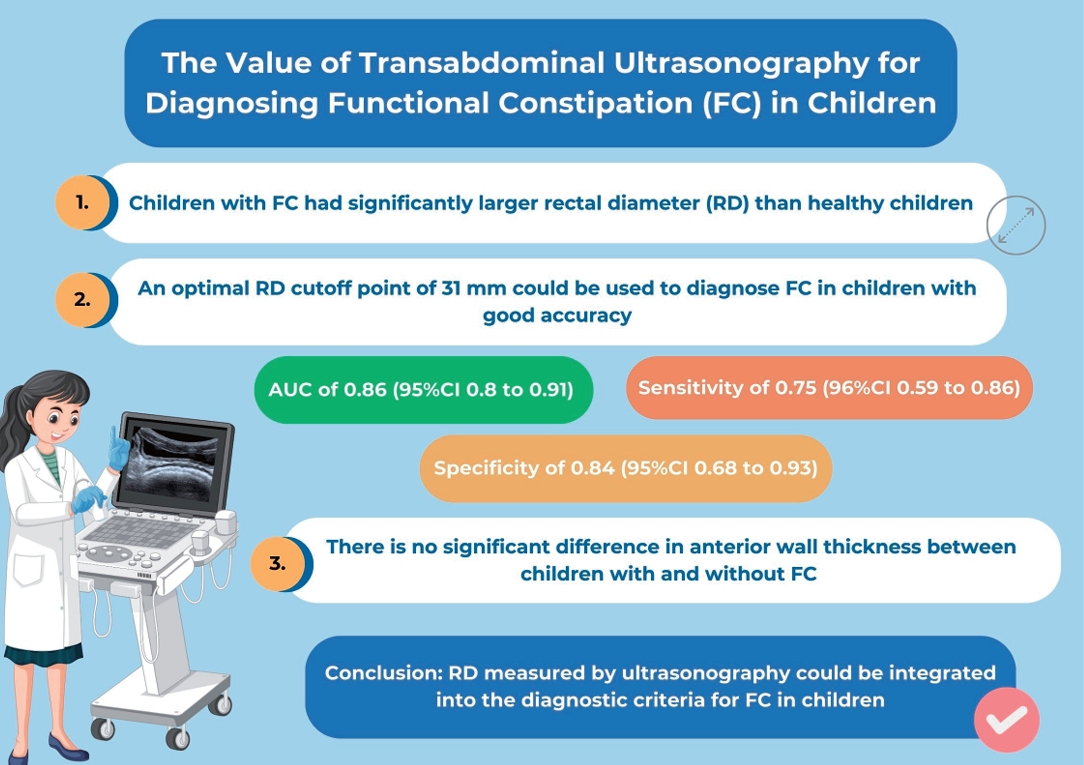
Transabdominal ultrasonography is increasingly used as a novel modality for detecting pediatric functional constipation (FC). This systematic review and metaanalysis aimed to assess the diagnostic parameters of FC including rectal diameter (RD) and anterior rectal wall thickness. A systematic search was conducted of the Ovid MEDLINE, Embase, Scopus, and PubMed databases through September 29, 2023, to identify studies comparing RD...
-

-
-
6.02024CiteScore98th percentilePowered by
-
Impact Factor3.6
-
- TOPICS
- ARTICLE CATEGORY
- Editorial Office
-
Korean Pediatric Society
#1606 Seocho World Officetel, 19 Seoun-ro, Seocho-ku, Seoul 06732, Korea
Tel: +82-2-3473-7306 Fax: +82-2-3473-7307 E-mail: office@e-cep.org
Clinical and Experimental Pediatrics is an open access journal. All articles are distributed under the terms of the Creative Commons Attribution NonCommercial License (http://creativecommons.org/licenses/by-nc/4.0/)
Copyright © 2025 by Korean Pediatric Society.











